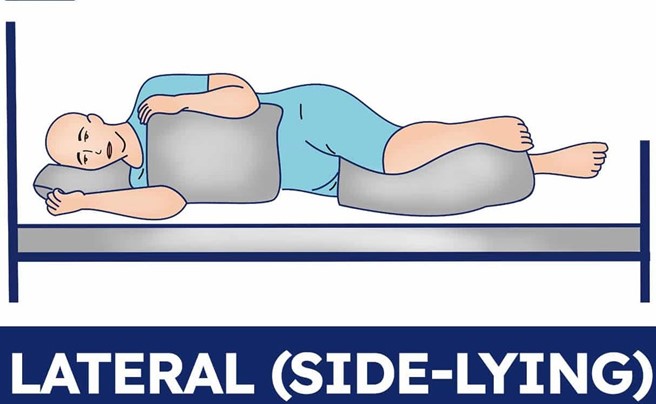A nurse is assisting with the care of a client who had an epidural anesthesia block during the early stages of labor. The client's blood pressure is 80/40 mm Hg and the fetal heart recording is 140/min. Which of the following actions should the nurse take first?
Place the client in a lateral position.
Notify the provider.
Increase IV fluid rate.
Elevate the legs.
The Correct Answer is A
Choice A reason:
Placing the client in a lateral position is the first action the nurse should take, as it can improve maternal and fetal circulation by relieving pressure on the inferior vena cava. The client's blood pressure is low, which can indicate hypotension due to epidural anesthesia or supine hypotension syndrome.
Choice B reason:
Notifying the provider is an important action, as it can facilitate further interventions and monitoring for the client and the fetus. However, this is not the first action the nurse should take, as it does not address the immediate problem of hypotension.
Choice C reason:
Increasing IV fluid rate is an important action, as it can expand blood volume and increase blood pressure. However, this is not the first action the nurse should take, as it may not be effective if the client is in a supine position.
Choice D reason:
Elevating the legs is an important action, as it can enhance venous return and increase blood pressure. However, this is not the first action the nurse should take, as it may worsen supine hypotension syndrome by increasing pressure on the inferior vena cava.

Nursing Test Bank
Naxlex Comprehensive Predictor Exams
Related Questions
Correct Answer is C
Explanation
Choice A reason: Three fingerbreadths above the umbilicus is incorrect, as this position indicates a higher than expected fundal height for a client who is 12 hr postpartum. The fundus is normally at the level of the umbilicus immediately after birth and then descends about one fingerbreadth per day. A high fundal height can indicate uterine atony, retained placental fragments, or bladder distension.
Choice B reason: One fingerbreadth above the symphysis pubis is incorrect, as this position indicates a lower than expected fundal height for a client who is 12 hr postpartum. The fundus is normally at the level of the umbilicus immediately after birth and then descends about one finger-breadth per day. A low fundal height can indicate uterine inversion, which is a rare but life-threatening complication.
Choice C reason: At the level of the umbilicus is correct, as this position indicates a normal and expected fundal height for a client who is 12 hr postpartum. The fundus is normally at the level of the umbilicus immediately after birth and then descends about one finger-breadth per day. A midline and firm fundus indicates adequate uterine contraction and involution.
Choice D reason: To the right of the umbilicus is incorrect, as this position indicates a deviated fundus for a client who is 12 hr postpartum. The fundus should be midline and not displaced to either side. A deviated fundus can indicate bladder distension, which can interfere with uterine contraction and involution. The nurse should assist the client to empty their bladder and reassess the fundal position.

Correct Answer is D
Explanation
Choice A reason: "Babies know instinctively exactly how much of the nipple to take into their mouth." is incorrect, as this response does not provide adequate guidance or support for the client. Babies may not always latch on correctly or effectively, especially in the first few atempts. The nurse should teach the client how to position and latch the baby properly and observe for signs of effective breastfeeding.
Choice B reason: "Your baby's mouth is rather small so she will only take part of the nipple." is incorrect, as this response can lead to ineffective breastfeeding and nipple trauma. Taking only part of the nipple can cause poor milk transfer, inadequate milk production, and nipple soreness or cracking. The nurse should teach the client how to ensure that the baby takes enough of the nipple and areola into their mouth.
Choice C reason: "Try to place the nipple, the entire areola, and some breast tissue beyond the areola into her mouth." -Including too much breast tissue can be uncomfortable. While some areola is important, including too much breast tissue can hinder proper latch and milk flow.
Choice D reason: "You should place your nipple and some of the areola into her mouth." This accurately describes the ideal latch for breastfeeding. Including some of the areola helps the baby latch deeply and comfortably, promoting milk transfer and preventing feeding difficulties and nipple soreness.
Whether you are a student looking to ace your exams or a practicing nurse seeking to enhance your expertise , our nursing education contents will empower you with the confidence and competence to make a difference in the lives of patients and become a respected leader in the healthcare field.
Visit Naxlex, invest in your future and unlock endless possibilities with our unparalleled nursing education contents today
Report Wrong Answer on the Current Question
Do you disagree with the answer? If yes, what is your expected answer? Explain.
Kindly be descriptive with the issue you are facing.
